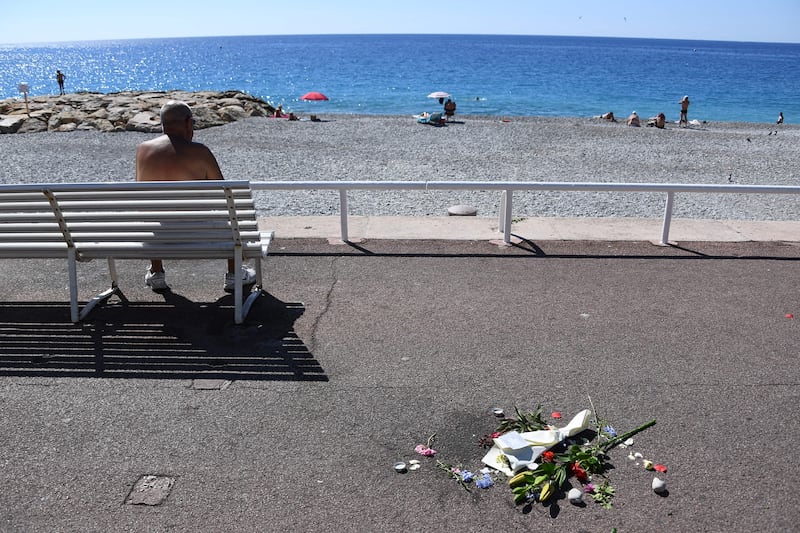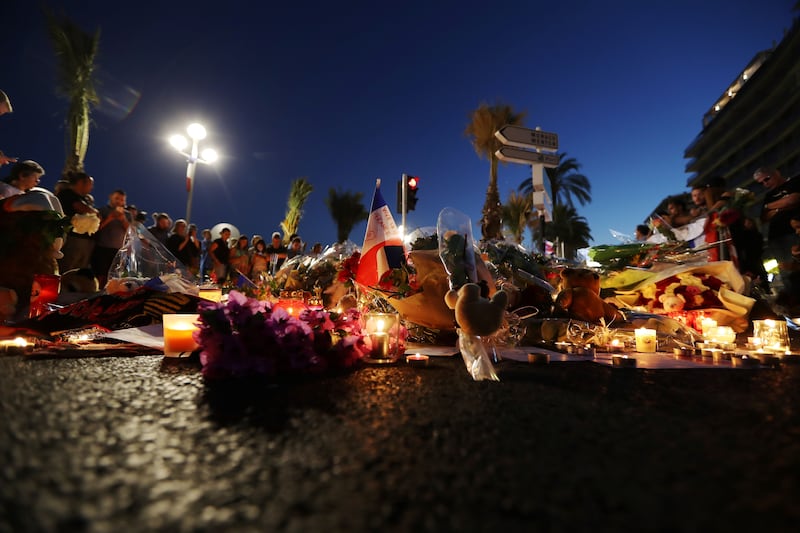When the tents were folded last weekend in Nice and the energy of a Rugby World Cup weekend dissipated around the streets, the stragglers and those who stayed on for an extra day to wander the city and hang around the beaches made their way towards the seafront cafes.
Across the road from the chosen hangout for the week, Dolce Momento, a young girl wearing the colours of Japan jumped up to perform a balancing act on what looked, from a short distance away, like a taut thick rope between two sturdy posts.
She was standing on a barrier that separated the road along the coast with the adjacent promenade, a broad walkway with cycling lanes to one side. On closer inspection, it was not a rope or a pole but the higher of two thick steel cables pulled between metal bollards sunk deep into the ground.
The brutal path of the stumps of iron and steel rigging stretch for several kilometres along the length of the Promenade des Anglais. Painted white, the same colour as the flag poles and railings separating the walkway from the beach 12 feet below, the thick round cable the Japanese fan had been walking across is a relatively recent addition.
READ MORE
It was installed to stop road vehicles deliberately mounting the walkway. It is there to impede or prevent mass murder.
The historians of the city will tell you that the construction of the Terrasses in the 1770s and the opening of the rooftop promenade along the coastline changed the relationship between Nice and the sea forever. The change allowed for the creation of an original, entirely coastal promenade dedicated to leisure, the first ever for that purpose, say the tourist books.

But what took place just over seven years ago, when Mohamed Lahouaiej-Bouhlel deliberately drove a 19-tonne truck into a crowd of Bastille Day revellers, murdering 86 people, including 15 children in one of the deadliest terror attacks on European soil in the 21st century, meant that the history of the promenade was again changed forever.
Late last year, the trials over the Nice attack came to an end, with eight people convicted for the killings, excluding the driver of the truck, who had died at the scene after being shot by police. Yet it was pointed out by several commentators that it seemed like hardly anyone outside France was paying attention.
Robert McLiam Wilson, who reported last October from the Palais de Justice in Paris, wrote about it in The Guardian. It was not upbeat. “You’d think it would be a big deal. You would be wrong,” he said.
Wilson talks about the 2015 attacks on the satirical magazine Charlie Hebdo; the Hyper Cacher supermarket in Paris; and the November 2015 attacks on a range of venues across Paris – including the Stade de France and the Bataclan concert hall – that killed 130 people. But no one remembers much of anything about the slaughter in Nice because, he says, Nice is Apollo 12. Nobody remembers Apollo 12. They remember Apollo 11.
What comes through in the aftermath is that the story of Nice is about limits to our compassion, barriers to how much empathy can be given and how much pity we can take on without being pulled down ourselves. Our levels are set no matter what the outrage.

The trial heard 280 witness statements, one horror after another, as a traumatised mother was followed by a traumatised wife who was followed by a traumatised man who lost six members of his family as Lahouaiej-Bouhlel, in his medieval rampage, ran over anyone in the crowd of thousands that had gathered to celebrate.
A report from a French news agency spoke of a former professional footballer called Jérôme, who opened the doors of his nightclub to those trying to escape. Ninety were given first aid and two people died in his premises. He spoke of the wild panic and how the crowd fleeing from the promenade into the back streets were in such great numbers that they drove himself and a policemen back, as they tried to reach the truck.
He, like many of the others, now lives in a world of guilt and pain, of not being able to help a dead family member, not being able to stop the truck or save children, not being able to adequately attend the critically injured.
It was, said Wilson, “a franchised form of terrorism”. The driver of the truck did not go abroad to train and wasn’t a member of al-Qaeda or connected to Isis or any other committed terrorist groups. He was, said Wilson, “just a loser who hated his life ... got in a lorry and killed a lot of people and attached a theory to it.”
There is a monument to the dead, a fountain in a municipal park somewhere in Nice. I couldn’t find it. People have campaigned for something more visible, where many of the killings occurred. But there is no reminder on the Promenade des Anglais apart from the stumps of steel and the iron rigging on which the young Japanese girl was playing.
Maybe Nice doesn’t want a constant reminder of anything other than being what it is, a place where tourists and Rugby World Cups come to dip their feet in the water, bathe their bodies in the sun and leave.
But for those bound to never be able to forget, the lorry didn’t just travel in distance, but in time, and the lorry will never stop travelling.


















